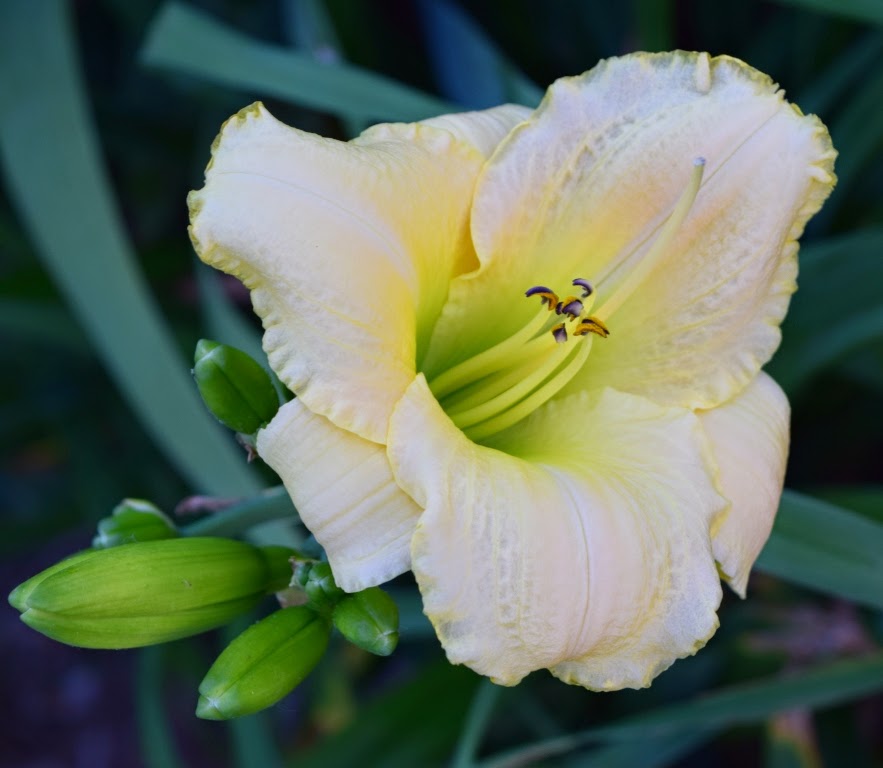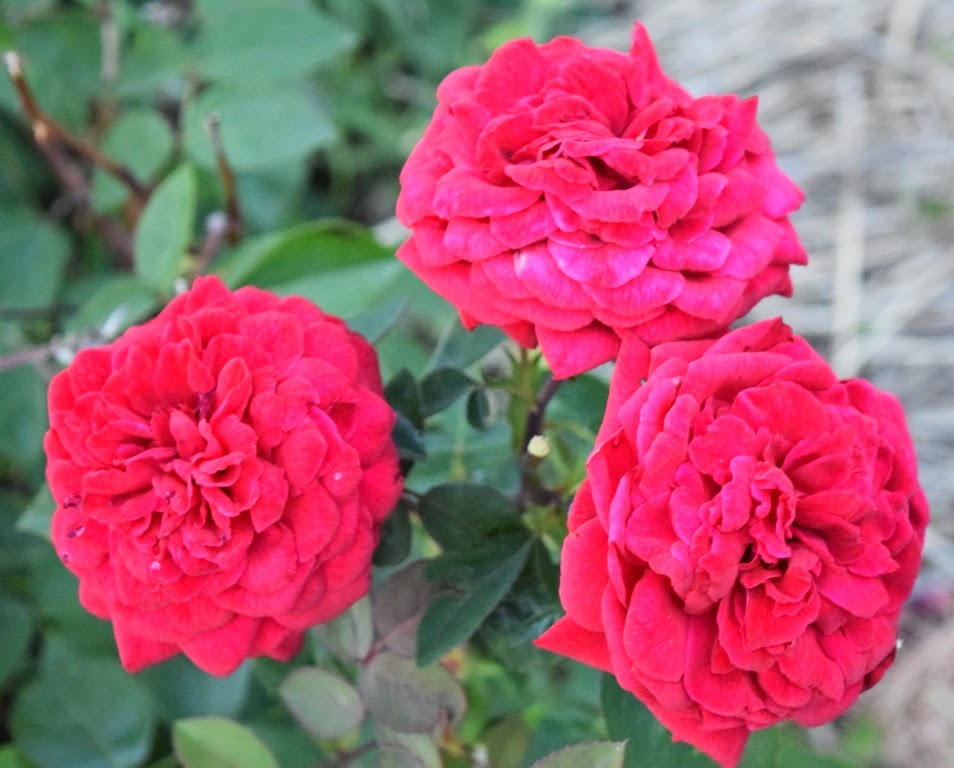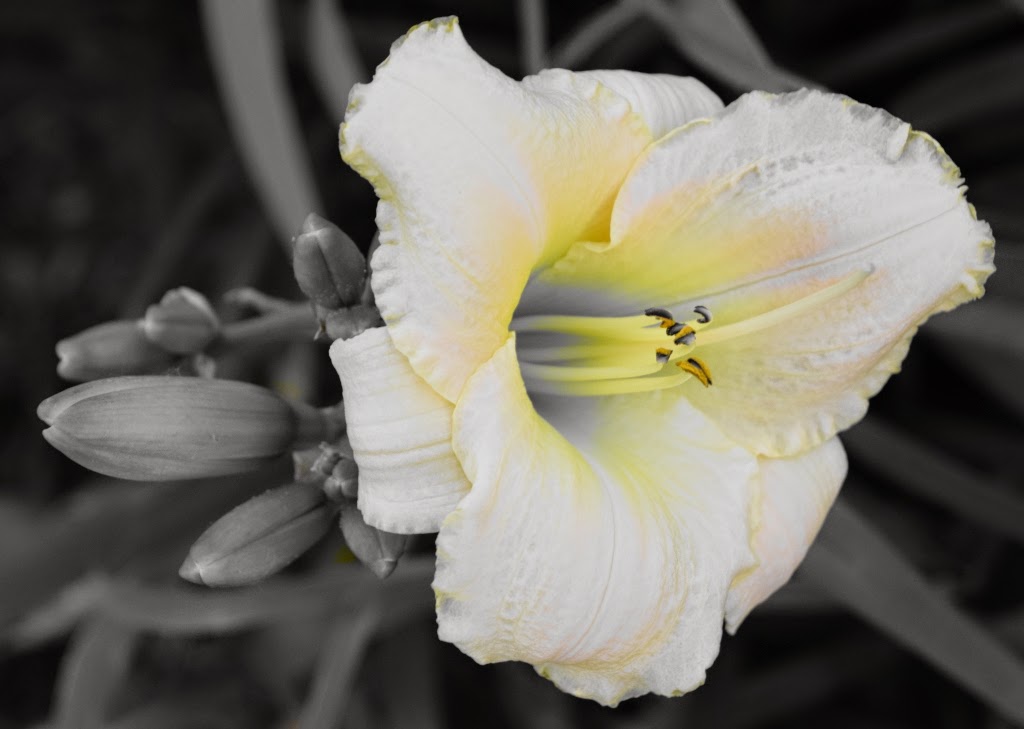 |
| 'Frosted Vintage Ruffles' |
I like pink day-lilies and I cannot lie
You other gardeners can't deny
When a bud pops open
with a pretty lacy bloom
And a pink that's over the moon
You feel young
Sung, of course, to the melody of
Baby Got Back. I'm not in the habit of singing rap composed by Sir Mix-A-Lot, but I couldn't help thinking of this one in regards to my pink daylilies. I would advise older male gardeners who like my revised lyrics to make sure they sing the words rather than hum it when they are near their spouses. Most wives just don't seem to react well to spouses humming
Baby Got Back in their near vicinity. Ask me how I know.
.jpg) |
| 'Siloam Double Classic' |
I realized, as the main daylily bloom came on this past week, that this year it is the pink-toned daylilies that are bringing me the most pleasure. And not just any pink daylily, but primarily those with clear clean pink tones. From top to bottom, the first three daylilies pictured here are 'Frosted Vintage Ruffles', 'Siloam Double Classic', and an anonymous beautiful pink daylily that I'm in love with. You can be sure that I'll be dividing these clumps to spread others around my garden this Fall.
.jpg) |
| 'Jolyene Nichole'??? |
Of these three, 'Frosted Vintage Ruffles', a 2000 introduction by Begnaud, is my favorite for its delicate porcelain petals, the shading from light to dark pink, and its excellent fragrance. 'Siloam Double Classic', by Henry in 1985, is indeed a classic and a multiple award-winner including a Stout Silver Medal Runner-up. It deserves a place in everyone's garden. The name of the third daylily has been lost to my poor records system, but is likely either 'Jolyene Nichole' or 'Siloam Full Dress'. The former looks a lot like it, but the latter's description also fits and I can't find a picture of it online for comparison. I've got a huge clump of it shining pink at me from all the way across the garden.
 |
| 'Bubblegum Delicious' |
Pinks that are not quite so pure are doing nothing for my soul this year. This fourth daylily, 'Bubblegum Delicious' is a more recent (2010) introduction by Kelly Mitchell that I planted in 2013, but despite all the edging and ruffles, it leaves me unimpressed. The overall combination is just a bit too gaudy for my tastes. Daylilies are just getting too fancy for me.
(returning to Baby Got Back)...
So Gardeners! (Yeah!), Gardeners! (Yeah!)
Is your daylily good and pink? (Heck yeah!)
Then you should show it (Show it!)
Show it! (Show it!)
Show off that healthy bloom!
Daylily Got Pink!
.jpg) I am a gardener that spends most of my garden time looking down at the level of my feet, peering into the depths of each flower in search of beauty, examining each leaf closely for evidence of insect damage or fungus, standing fast against the tiny advance guard of marauding weeds. I rarely take the time to glance up into the greater world and appreciate the wider views of my garden. I could probably blame my approach to gardening on my surgical training because of the similar approach when I concentrate on a surgery. In one moment, in a surgery, the world is small, the length of an incision or of a bone fragment. The work completed, I take a breath and suddenly there is a bright room, with people and beeping anesthesia machines and the clank of instruments thrown back onto the table. My innate focus on the activity at hand, however, is probably not training but is simply my nature and perhaps why I enjoy both my vocation and my hobby. Anyway, the lesson for the today is to try not to be like me.
I am a gardener that spends most of my garden time looking down at the level of my feet, peering into the depths of each flower in search of beauty, examining each leaf closely for evidence of insect damage or fungus, standing fast against the tiny advance guard of marauding weeds. I rarely take the time to glance up into the greater world and appreciate the wider views of my garden. I could probably blame my approach to gardening on my surgical training because of the similar approach when I concentrate on a surgery. In one moment, in a surgery, the world is small, the length of an incision or of a bone fragment. The work completed, I take a breath and suddenly there is a bright room, with people and beeping anesthesia machines and the clank of instruments thrown back onto the table. My innate focus on the activity at hand, however, is probably not training but is simply my nature and perhaps why I enjoy both my vocation and my hobby. Anyway, the lesson for the today is to try not to be like me..jpg) I was struck recently, walking Bella and passing by the northeast facing "entrance" to my back patio (shown above left), that a tall pillar rose on the left and the house on the right frame an almost good vista, the fake path stones leading one's eye to the patio and the statue and steps at the other end beckoning onward. I was also struck by the fact that I know the view from top of the steps at the other end, shown to the right here, is not quite as artful, no frame to draw the eye and the satellite disk rudely imposing on the scene.
I was struck recently, walking Bella and passing by the northeast facing "entrance" to my back patio (shown above left), that a tall pillar rose on the left and the house on the right frame an almost good vista, the fake path stones leading one's eye to the patio and the statue and steps at the other end beckoning onward. I was also struck by the fact that I know the view from top of the steps at the other end, shown to the right here, is not quite as artful, no frame to draw the eye and the satellite disk rudely imposing on the scene..jpg) But those observations did serve to lead me into a search for other pleasing vistas in my garden and I learned once again that finding beauty is often simply a matter of one's perspective. A frontal view of this peony bed, with peonies, mockorange, and honeysuckle in full bloom is not nearly so interesting as the "long axis" view at the left, with the curved line of the bed drawing our eyes down it. It was a fabulous Spring morning, that day I took this photo.
But those observations did serve to lead me into a search for other pleasing vistas in my garden and I learned once again that finding beauty is often simply a matter of one's perspective. A frontal view of this peony bed, with peonies, mockorange, and honeysuckle in full bloom is not nearly so interesting as the "long axis" view at the left, with the curved line of the bed drawing our eyes down it. It was a fabulous Spring morning, that day I took this photo. .jpg) And likewise, my lavender border, frozen back and beaten down by a harsh winter, looks like forty miles of bad road until the gardener or visitor takes a position to look along the bed, focusing on the upended limestone rock at the center. The light blues, purples, grays and greens are so soothing that I could sit and look at this picture all day long.
And likewise, my lavender border, frozen back and beaten down by a harsh winter, looks like forty miles of bad road until the gardener or visitor takes a position to look along the bed, focusing on the upended limestone rock at the center. The light blues, purples, grays and greens are so soothing that I could sit and look at this picture all day long. .JPG) I need to remember to look up far more often. I live in a place where the sky and the land meet sometimes to form a fantastic view, a vista that only needs to be carefully framed to release the magic within it. Two steps to the right and several feet forward and the picture at the left, of the low clouds, distant fog and my neighbor's house, could have been an even better memory of a special early morning. We merely need to always remember to look for the beauty, frame it, and file it away, in a picture or in that collection of neural paths called a memory. Beauty is indeed in the eye of the beholder, but it is certainly enhanced and improved by the perspective of the beholder.
I need to remember to look up far more often. I live in a place where the sky and the land meet sometimes to form a fantastic view, a vista that only needs to be carefully framed to release the magic within it. Two steps to the right and several feet forward and the picture at the left, of the low clouds, distant fog and my neighbor's house, could have been an even better memory of a special early morning. We merely need to always remember to look for the beauty, frame it, and file it away, in a picture or in that collection of neural paths called a memory. Beauty is indeed in the eye of the beholder, but it is certainly enhanced and improved by the perspective of the beholder..jpg)
.jpg)

.jpg)
.jpg)

.jpg)
.jpg)
.jpg)
.jpg)
.jpg)

.jpg)
.jpg)
.jpg)






.jpg)
.jpg)
.jpg)
.jpg)
.jpg)
.jpg)
.jpg)
.jpg)
.jpg)
.jpg)
.jpg)

.jpg)




.jpg)



.jpg)
b.jpg)
.JPG)
.JPG)